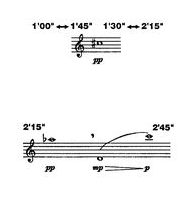John Cage String Quartet Pdf


Title String Quartet in 4 Parts Date Composed between 1949 and 1950. Premiered in Black Mountain, N.C., August 12, 1950. Ensemble Type String Quartet Work Length 20 minutes Instrumentation For string quartet. Comments This work consists of four movements: Quietly flowing along - Slowly rocking - Nearly stationary - Quodlibet.
Cage John String Quartets - Download as PDF File (.pdf), Text File (.txt) or read online. Title String Quartet in 4 Parts. Date Composed between 1949 and 1950. Premiered in Black Mountain, N.C., August 12, 1950. Ensemble Type String Quartet. Work Length 20 minutes. Instrumentation For string quartet. Comments This work consists of four movements: Quietly flowing along - Slowly rocking - Nearly.
Jan 16, 2018 - John Cage String Quartet Pdf. Classical Music from the largest Classical Music Label. Listen to CDs/Recordings/Compositions Online and stay up to date with classical music news and reviews. A string quartet is a musical ensemble of four string players – two violin players, a viola player and a cellist – or a. After hearing Schoenberg's lecture analyzing the String Quartet No. 30, and rehearsals and performances of the work by the Los Angeles-based Abas String. Quartet, he wrote: About a week ago I had another unusual dream: I heard the entire III. String Quartet in my sleep.6. By contrast, Cage's letters to Weiss had an.
The rhythmic structure is an unvarying 2 1/2, 1 1/2, 2, 3, 6, 5, 1/2, 1 1/2, for a total of 22 units of 22 measures each. It is a work of great simplicity, reminiscent of Erik Satie and in a way a further step toward Cage’s abandonment of self-expression. Geometry And Discrete Mathematics 125. As in his Sonatas and Interludes, it deals with the nine permanent emotions of Indian philosophy (see Sonatas and Interludes), as well as the Indian notion of the seasons, i.e. Creation, preservation, destruction, and quiescence. In the first movement, the subject is Summer in France, in the second it is Fall in America. The third movement is about Winter, and the fourth, about Spring, is a welcome and quite sprightly quodlibet. The work uses gamuts of sound, as do most of Cage’s compositions from this period.
The collection of sonorities here is relatively small and never transposed, fragmented, or arpeggiated. For more background information on the gamut technique, see Cage's Defense of Satie (In John Cage - An Anthology, edited by Richard Kostelanetz - pp.
77-84) and The Music of John Cage by James Pritchett (pp. The strings here are played without vibrato, and those to be used for tone production are specified. Dedicatee(s) Lou Harrison Publication Peters Edition EP 6757 (score), EP 6757a (parts). Orca3d Cracker more.